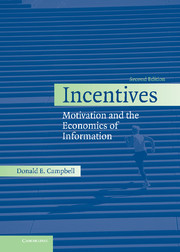Book contents
- Frontmatter
- Contents
- Preface to the Second Edition
- 1 Equilibrium, Efficiency, and Asymmetric Information
- 2 Basic Models and Tools
- 3 Hidden Action
- 4 Corporate Governance
- 5 Hidden Characteristics
- 6 Auctions
- 7 Voting and Preference Revelation
- 8 Public Goods and Preference Revelation
- 9 Matching
- 10 General Competitive Equilibrium
- References
- Author Index
- Subject Index
3 - Hidden Action
- Frontmatter
- Contents
- Preface to the Second Edition
- 1 Equilibrium, Efficiency, and Asymmetric Information
- 2 Basic Models and Tools
- 3 Hidden Action
- 4 Corporate Governance
- 5 Hidden Characteristics
- 6 Auctions
- 7 Voting and Preference Revelation
- 8 Public Goods and Preference Revelation
- 9 Matching
- 10 General Competitive Equilibrium
- References
- Author Index
- Subject Index
Summary
This chapter and the next investigate the extent to which an agent can be motivated to act in the principal's interest when the principal cannot determine whether the agent has in fact taken the appropriate action. Agents' behavior is problematic because their goal is to maximize their own utility. The next chapter is devoted to the specific hidden action problem of motivating workers and management in a firm, with the latter receiving most of our attention. This chapter examines a wide variety of other issues. In many of these the principal is a surrogate for society as a whole, and the principal's utility is maximized when the agents—the producers and consumers—are all motivated to do their part in contributing to an efficient outcome.
As with all hidden information problems, there are hidden characteristic elements as well as the hidden action element. In fact, some of the topics could have been presented as hidden characteristic problems. For instance, we could study resource allocation from the standpoint of inducing consumers to reveal their hidden preferences and firms to reveal their hidden production technologies so that an efficient outcome can be identified. However, the approach taken in the first section is that of inducing each individual to choose a bundle of goods and services at which his or her marginal rate of substitution equals that of the other consumers.
- Type
- Chapter
- Information
- IncentivesMotivation and the Economics of Information, pp. 136 - 195Publisher: Cambridge University PressPrint publication year: 2006
- 1
- Cited by

